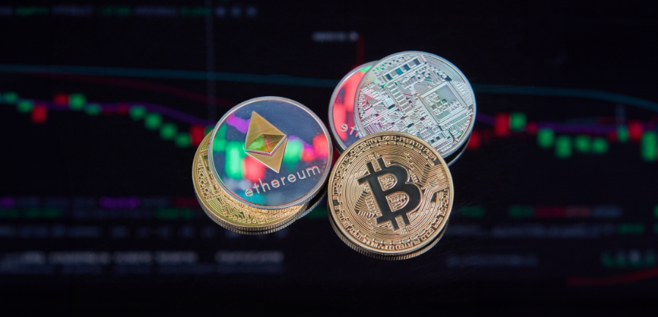Published 25 Apr 2024
Ratex.ai/
- Blog/
- Investment/
- Navigating Crypto Market Volatility: A Comprehensive Guide to Risk Management
Navigating Crypto Market Volatility: A Comprehensive Guide to Risk Management

Cryptocurrencies represent a dynamic and rapidly evolving landscape, characterized by significant price fluctuations and unique opportunities. Operating on blockchain technology, these digital assets utilize advanced cryptographic techniques to secure transactions and maintain a decentralized network. While Bitcoin remains the most well-known cryptocurrency, the market hosts a multitude of alternative coins, each with distinct features and applications.
The crypto market's inherent volatility sets it apart from traditional financial markets, presenting both potential rewards and risks for investors. To successfully navigate this landscape, it's crucial to develop effective risk management strategies.
This guide aims to provide users with a comprehensive understanding of risk management techniques tailored for the crypto market. By examining various strategies and tools, we hope to empower investors to make well-informed decisions and mitigate potential risks associated with crypto trading.

Understanding crypto market volatility
Crypto market volatility refers to the degree of price fluctuations experienced by cryptocurrencies over a given period. These fluctuations are often more dramatic than those observed in traditional financial markets, making the crypto market both an attractive and challenging environment for investors. Several factors contribute to the crypto market's volatility:
- Market size and liquidity
Compared to traditional markets, the crypto market is relatively small and less liquid. Lower liquidity can lead to more significant price swings, as even modest trades can impact market prices.
- Regulatory environment
The regulatory landscape for cryptocurrencies is still evolving, with varying levels of clarity and support from governments worldwide. Regulatory announcements, whether positive or negative, can cause substantial price movements.
- Media influence and market sentiment
The crypto market is highly sensitive to news and social media sentiment. Positive or negative coverage can quickly influence market sentiment, leading to rapid price changes.
- Technological developments
Updates, innovations, or setbacks in the underlying technology of a cryptocurrency can significantly impact its price and the broader market.
- Market manipulation
The crypto market's relative lack of regulation makes it more susceptible to manipulation, such as pump-and-dump schemes or insider trading.
To illustrate crypto market volatility, let's consider Bitcoin's price history. In 2017, Bitcoin's price surged from around 1,000 in January to nearly 20,000 in December, only to drop below $4,000 by the end of 2018. This dramatic price movement demonstrates the extreme volatility that investors may encounter in the crypto market. Understanding and preparing for such fluctuations is crucial for successful risk management.

The importance of risk management in crypto trading
Risk management is a vital aspect of trading in any financial market, but it takes on heightened significance in the crypto market due to its extreme volatility. Effective risk management enables investors to protect their capital, minimize potential losses, and maximize returns in the long run. The potential risks of crypto trading include:
- Market volatility
Rapid and significant price fluctuations can lead to substantial losses if investors are not prepared or do not employ appropriate risk management strategies.
- Regulatory risks
Changes in the regulatory environment can impact the value and usability of cryptocurrencies, potentially leading to losses for investors.
- Security risks
The digital nature of cryptocurrencies exposes investors to security threats, such as hacking, phishing, and theft.
- Liquidity risks
Lower liquidity in some cryptocurrencies can make it challenging to buy or sell assets quickly without affecting the market price.

Despite these risks, crypto trading offers potential rewards:
- High growth potential
The crypto market's volatility can create opportunities for substantial gains, as demonstrated by the rapid price appreciation of many cryptocurrencies.
- Diversification
Investing in cryptocurrencies can provide portfolio diversification, as their performance may not be directly correlated with traditional financial markets.
- Technological innovation
Engaging in the crypto market allows investors to support and benefit from the development of cutting-edge technologies, such as blockchain and decentralized finance (DeFi). To navigate the crypto market successfully, investors must strike a balance between managing risks and capitalizing on potential rewards. Implementing a well-thought-out risk management strategy can help investors make informed decisions, protect their investments, and maximize their chances of long-term success in the crypto market.

Risk management strategies
To effectively manage risks in the crypto market, investors can employ various strategies tailored to their investment goals and risk tolerance. Here, we discuss four popular risk management strategies:
Diversification
Diversification involves spreading investments across multiple assets to reduce exposure to any single asset's performance. In the context of crypto trading, diversification can be achieved by investing in a variety of cryptocurrencies with different market caps, use cases, and levels of risk. This approach helps mitigate potential losses from poor-performing assets, as gains in other investments may help offset any losses.
Position sizing
Position sizing refers to the amount of capital allocated to a particular investment. Managing position sizes is crucial for risk management, as investing too much in a single asset can expose investors to significant losses if the asset's value declines. A general rule of thumb is to limit the allocation of any single investment to a small percentage of the overall portfolio, ensuring that no single position can cause substantial damage to the investor's total capital.
Stop losses and take profits
Stop losses and take profits are tools used to automatically close a trade when a predetermined price level is reached. A stop-loss order helps limit potential losses by selling an asset when its price falls to a specified level, while a take-profit order locks in gains by selling an asset when its price reaches a desired level. By employing these tools, investors can manage their risk exposure and maintain a disciplined approach to trading.
Dollar-cost averaging (DCA)
Dollar-cost averaging is a strategy that involves investing a fixed amount of money at regular intervals, regardless of the asset's price. This approach helps mitigate market volatility, as investors buy more of an asset when prices are low and less when prices are high. Over time, DCA can help reduce the overall average cost of an investment and smooth out the impact of short-term price fluctuations. By incorporating these risk management strategies into their investment approach, crypto traders can better navigate the market's volatility, protect their capital, and maximize their chances of long-term success.

Emotional control and psychology in crypto trading
Emotions can significantly impact trading decisions, often leading to impulsive actions that may not align with an investor's long-term goals. In the highly volatile crypto market, managing emotions and maintaining a clear mindset is crucial for making rational decisions and avoiding costly mistakes. The role of emotions in trading decisions:
- Fear
Fear of missing out (FOMO) can drive investors to make hasty decisions, such as buying an asset at inflated prices or selling too early due to panic.
- Greed
The desire for quick profits can lead investors to take excessive risks, invest in dubious projects, or hold onto losing positions in the hope of a rebound.
- Hope
Holding onto losing positions in the hope of a price recovery can result in further losses, as investors may ignore warning signs or fail to set appropriate stop losses.

To keep emotions in check and maintain a disciplined approach to crypto trading, consider the following tips:
- Stick to a trading plan
Develop a well-thought-out trading plan that outlines your investment goals, risk tolerance, and strategies for entering and exiting positions. Adhering to this plan can help you make rational decisions and avoid impulsive actions driven by emotions.
- Set realistic expectations
Understand that the crypto market is volatile, and not every investment will yield substantial returns. Setting realistic expectations can help you maintain a balanced perspective and avoid taking excessive risks.
- Practice patience
Resist the urge to make impulsive decisions based on short-term market movements. Instead, focus on your long-term investment goals and maintain a patient approach to trading.
- Stay informed
Regularly educate yourself about the crypto market, its trends, and the projects you invest in. This knowledge can help you make informed decisions and feel more confident in your trading choices.
- Maintain a healthy lifestyle
Emotional well-being is closely linked to physical health. Ensure you get adequate sleep, exercise, and nutrition to maintain a clear mindset and make rational trading decisions. By managing emotions and maintaining a disciplined approach to crypto trading, investors can make more informed decisions, minimize potential losses, and increase their chances of long-term success in the crypto market.

Staying informed: the role of research and education
In the rapidly evolving world of cryptocurrencies, staying informed and educated is crucial for making well-informed decisions and staying ahead of the curve. Regularly updating your knowledge about market news, trends, and technological advancements can significantly contribute to your success as a crypto trader. The importance of staying updated with market news and trends:
- Identifying opportunities
Keeping track of market developments can help you identify potential investment opportunities, such as new projects with strong fundamentals or emerging trends that could impact the value of specific cryptocurrencies.
- Mitigating risks
Staying informed about regulatory changes, security threats, or other factors that may negatively affect the crypto market can help you mitigate risks and adjust your investment strategies accordingly.
- Understanding market sentiment
Monitoring news and social media can provide insights into market sentiment, which often plays a significant role in the crypto market's price movements.

The role of ongoing education in successful crypto trading:
- Enhancing knowledge
Regularly educating yourself about various aspects of crypto trading, such as technical analysis, fundamental analysis, and risk management, can help you make more informed decisions and improve your overall trading skills.
- Adapting to change
The crypto market is constantly evolving, with new technologies, projects, and regulations emerging regularly. Ongoing education can help you adapt to these changes and stay competitive in the market.
- Building confidence
As you expand your knowledge and understanding of the crypto market, you'll likely feel more confident in your trading decisions, which can lead to better risk management and increased success.

To stay informed and educated, consider the following practices:
- Follow reputable news sources
Regularly read articles and updates from trusted news outlets, blogs, and research platforms to stay current on market developments.
- Engage in online communities
Join forums, social media groups, and online discussions to connect with other crypto enthusiasts and traders, share insights, and learn from their experiences.
- Attend conferences and workshops
Participate in industry events, webinars, and workshops to gain valuable insights from experts, network with like-minded individuals, and stay updated on the latest trends and innovations.
- Pursue self-directed learning
Take advantage of the numerous online courses, tutorials, and educational resources available to expand your knowledge and skills in crypto trading and related topics. By prioritizing ongoing research and education, you can stay informed about the dynamic crypto market, make well-informed trading decisions, and enhance your chances of long-term success.

Conclusion
Navigating the crypto market's volatility can be challenging, but with a well-thought-out risk management strategy, investors can protect their capital and maximize their chances of long-term success. In this article, we have discussed the importance of risk management in crypto trading, explored various risk management strategies, and emphasized the role of emotional control, research, and ongoing education.
Let's recap the main points:
- Crypto market volatility presents both risks and opportunities for investors.
- Effective risk management is crucial for protecting capital, minimizing potential losses, and maximizing returns.
- Strategies such as diversification, position sizing, stop losses and take profits, and dollar-cost averaging can help manage risks in the crypto market.
- Emotional control and maintaining a disciplined approach to trading are essential for making rational decisions and avoiding costly mistakes.
- Staying informed and educated about market news, trends, and technological advancements is vital for making well-informed decisions and staying ahead of the curve.
For beginners embarking on their crypto journey, it's crucial to prioritize risk management and approach trading with a clear, disciplined mindset. By staying informed, employing effective risk management strategies, and maintaining emotional control, new investors can navigate the crypto market's volatility with confidence and increase their chances of long-term success.
Read More




 Get RateX Pro
Get RateX Pro
 21 Apr 2024
21 Apr 2024
